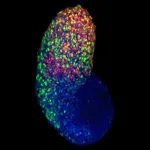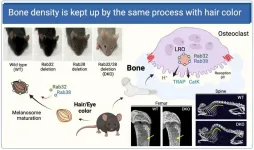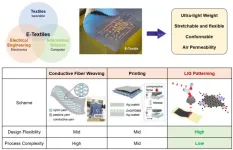(Press-News.org) COLUMBUS, Ohio – The discovery of a physical interaction between two proteins in brain cells that can be traced in mice to control of movement, anxiety and memory could one day open the door to development of new schizophrenia treatment strategies, researchers say.
The research group is the first to determine that the two proteins, both among the dozens of proteins related to risk for the development of schizophrenia, bind to each other under normal conditions in multiple regions of the brain, and that their connection was found in mice to be key to maintaining normal movement, memory function and anxiety regulation.
When that connection doesn’t happen as it should, they found, behavior can be negatively affected – in mice, disruption to the proteins’ ability to interact increased hyperactivity, reduced risk avoidance and impaired memory. Though delusions and hallucinations are hallmark symptoms of schizophrenia, the condition also encompasses additional symptoms, including movement and memory problems.
“These two proteins are seemingly unrelated, and our study has provided a link between them that wasn’t recognized before,” said lead author Chen Gu, associate professor of biological chemistry and pharmacology in The Ohio State University College of Medicine.
“There are more than 100 genes that have been identified as risk genes for schizophrenia, but we still don’t know the real mechanisms behind those risks,” Gu said. “We’re hopeful that getting a better understanding of this mechanism could help in the long run to find a new treatment that could benefit patients with schizophrenia.”
The study was published recently in the journal Molecular Psychiatry.
Previous post-mortem studies have identified risk genes for schizophrenia based on signs of protein dysfunction detected in brain tissue. Among them are the proteins in this study: MAP6, which has a role in supporting a neuron’s cytoskeleton or, more specifically, microtubules, and Kv3.1, which helps control the maximal frequency of electrical signaling by neurons.
Gu’s lab has studied Kv3.1 for many years, often working with genetically altered mice lacking its gene. As the team began exploring a connection between Kv3.1 and MAP6, first study author Di Ma, a graduate student in the lab, found that mice lacking the genes for both proteins experienced similar behavior changes.
“That’s how we started looking at their relationship in more detail,” Gu said.
In this study, Ma and her lab mates took a more nuanced look at how the proteins’ connection relates to behavior by disrupting their ability to bind to each other in specific brain regions in mice: the hippocampus, which governs learning and memory, and the nearby amygdala, where emotions are processed.
The researchers found that disruption to the proteins’ connection in the amygdala led to a reduction in risk avoidance – shown in mice as a lack of fear of height. Blocking the proteins’ attachment in the hippocampus resulted in hyperactivity and lower recognition of a familiar object. Though some behavior changes in these experiments differed from the longer list of changes seen in mice completely lacking one or both genes, the finding provided important insights about where the proteins’ interactions, or lack thereof, have the strongest effect on behavior.
“Different physiological functions we are engaged in daily are governed by different brain regions,” Gu said. “That’s an advance provided by our study – because previously we only knew global knockout mice had these behavioral alterations, we didn’t really know what brain region was responsible for them.”
The next step in Gu’s lab will be exploring any links between social behavior in mice and these proteins’ functions in the prefrontal cortex, a brain region important to decision making and planning.
In a series of biochemistry and cell biology experiments, the researchers also determined how the proteins bind and how that connection affects their positioning inside neurons. Results showed MAP6 stabilizes the Kv3.1 channel in a specific type of interneurons, where it helps these cells keep brain signals at an even keel. A drop in the expression of MAP6, on the other hand, dramatically decreased the level of Kv3.1 in those interneurons.
The combined findings suggest that when the proteins don’t bind properly, there isn’t enough Kv3.1 available to maintain interneurons’ signal-control function, leading to an imbalance of neural inhibition and excitation in affected brain regions – and related negative behavioral symptoms. This type of interneurons, capable of generating nerve impulses in high frequencies, represent a key therapeutic target for schizophrenia.
“Our study further provides a link between the MAP6 dysfunction and the interneuron signal dysfunction, and we now know that there are two proteins that interact and that one could alter the other,” Gu said. “That opens up potential new directions for treatment strategies.”
This work was supported by grants from the National Institutes of Health.
Additional co-authors include Chao Sun, Rahul Manne, Tianqi Guo, Joshua Barry, Thomas Magliery and Houzhi Li of Ohio State and Christophe Bosc and Annie Andrieux of the Grenoble Institut Neurosciences in France.
#
Contact: Chen Gu, Gu.49@osu.edu
Written by Emily Caldwell, Caldwell.151@osu.edu; 614-292-8152
END
Thirty-seven research groups will receive €395 million in total to address some of the world’s most formidable research problems spanning a range of scientific disciplines. The funding helps groups of outstanding researchers to pool different skills, knowledge and resources to push the frontiers of our knowledge. The ERC Synergy Grant scheme is part of the EU's research and innovation programme, Horizon Europe.
Iliana Ivanova, Commissioner for Innovation, Research, Culture, Education and Youth, said: “Some scientific questions are too complex to be addressed by researchers working on their own. Challenges such as climate change or ...
An international team of researchers, led by IMDEA Networks and Northeastern University in collaboration with NYU Tandon School of Engineering, Universidad Carlos III de Madrid, IMDEA Software, University of Calgary, and the International Computer Science Institute, has unveiled groundbreaking findings on the security and privacy challenges posed by the ever-growing prevalence of opaque and technically complex Internet of Things (IoT) devices in smart homes.
Smart Homes: Trusted and Secure Environments?
Smart homes are becoming increasingly interconnected, ...
PULLMAN, Wash. -- A new tool to rapidly grow cancer-killing white blood cells could advance the availability of immunotherapy, a promising therapy which harnesses the power of the body’s immune response to target cancer cells.
Washington State University researchers have developed a minifridge-sized bioreactor that is able to manufacture the cells, called T cells, at 95% of the maximum growth rate – about 30% faster than current technologies. The researchers report on their work in the journal Biotechnology Progress. They developed it using T cells from cattle, developed by co-author Bill Davis of WSU’s ...
The Institute of Science and Technology Austria (ISTA) receives its second generous ERC Synergy Grant. ISTA Professor Gašper Tkačik is one of three awarded researchers to join forces on unraveling the secrets of gene regulation during mammalian development.
Three research groups from Austria and France team up to crack open the black box of early mammalian development. Now endowed with a prestigious Synergy Grant from the European Research Council (ERC), Gašper Tkačik (ISTA), Thomas Gregor (Institut Pasteur), ...
Osaka, Japan – A rapid, accurate way of testing for COVID-19 infection would be a big step in overcoming the virus’ hold over our society. Now, in an article published in Lab on a Chip, Japanese researchers have developed a promising solution: a novel platform that couples nanopore technology with artificial intelligence.
What is a nanopore? A nanopore is a miniscule hole in a thin substrate, often a silicon wafer. A nanopore might range from several nanometers to several hundred nanometers in diameter — a scale small enough to work with SARS-CoV-2, the virus that causes ...
The tropical wood type ipê is popular for building exclusive wooden decks, and in North America and Europe, the demand for the material has increased sharply. Now, a study from Chalmers University of Technology, Sweden, shows that more than three-quarters of all ipê from the top producing region in Brazil could have been harvested illegally. "The study reveals where in the chain the greatest risks lie. It can be a tool to counteract illegal logging," says Caroline S.S. Franca, PhD student at Chalmers.
Ipê is one of the world's hardest woods. It is therefore particularly suitable for building ...
In the future, farmed wolffish could start appearing on fish counters. However, a new thesis from the University of Gothenburg shows that this fish, with its delicate, firm flesh, needs somewhat different farming conditions compared to salmon.
The salmon farms of today have created a steady supply of fish in our supermarkets. The nutritional content of salmon, its rapid growth and low cost, have made it a popular fish in many households. But only farming one species can create vulnerabilities in terms of food security. Today Sweden ...
MSU has a satellite uplink/LTN TV studio and Comrex line for radio interviews upon request.
THIS STORY IS UNDER EMBARGO UNTIL OCT. 26 AT 12:01 A.M. EDT/05:01 A.M. U.K. TIME.
Images
Highlights:
Researchers at Michigan State University have developed a framework that can help scientists understand trends in biodiversity by using data from well-characterized species to provide insights on data-deficient species.
The framework is published in the Journal of Animal Ecology, which provides a how-to guide for researchers and practitioners to implement.
Roughly one in seven species are classified ...
Osaka, Japan – Bone is maintained via delicate balance between formation and resorption, and its imbalance leads to bone related diseases like osteoporosis rheumatism and periodontitis. In studies published in scientific journals J Biol Chem and Cell Struct Funct, researchers led by Osaka University revealed proteins named Rab32 and Rab38 play pivotal roles in bone resorption in osteoclast, cell specialized in the process. These proteins are also crucial for pigmentation of hair and skins.
Bone ...
Multimodal* graphene-based electronic textiles (e-textiles) for the realization of customized e-textiles have been developed for the first time in the world.
* Multimodal means the process by which information is exchanged through various sensory interfaces such as visual sensation and auditory sensation.
The joint research team led by Principal Researcher Soongeun Kwon of the Department of Nano Manufacturing Technology of the Korea Institute of Machinery and Materials (President Sang-jin Park, hereinafter referred to as KIMM), an institute under the jurisdiction of the Ministry of Science and ICT, and Professor Young-Jin Kim of the Department of Mechanical Engineering ...






